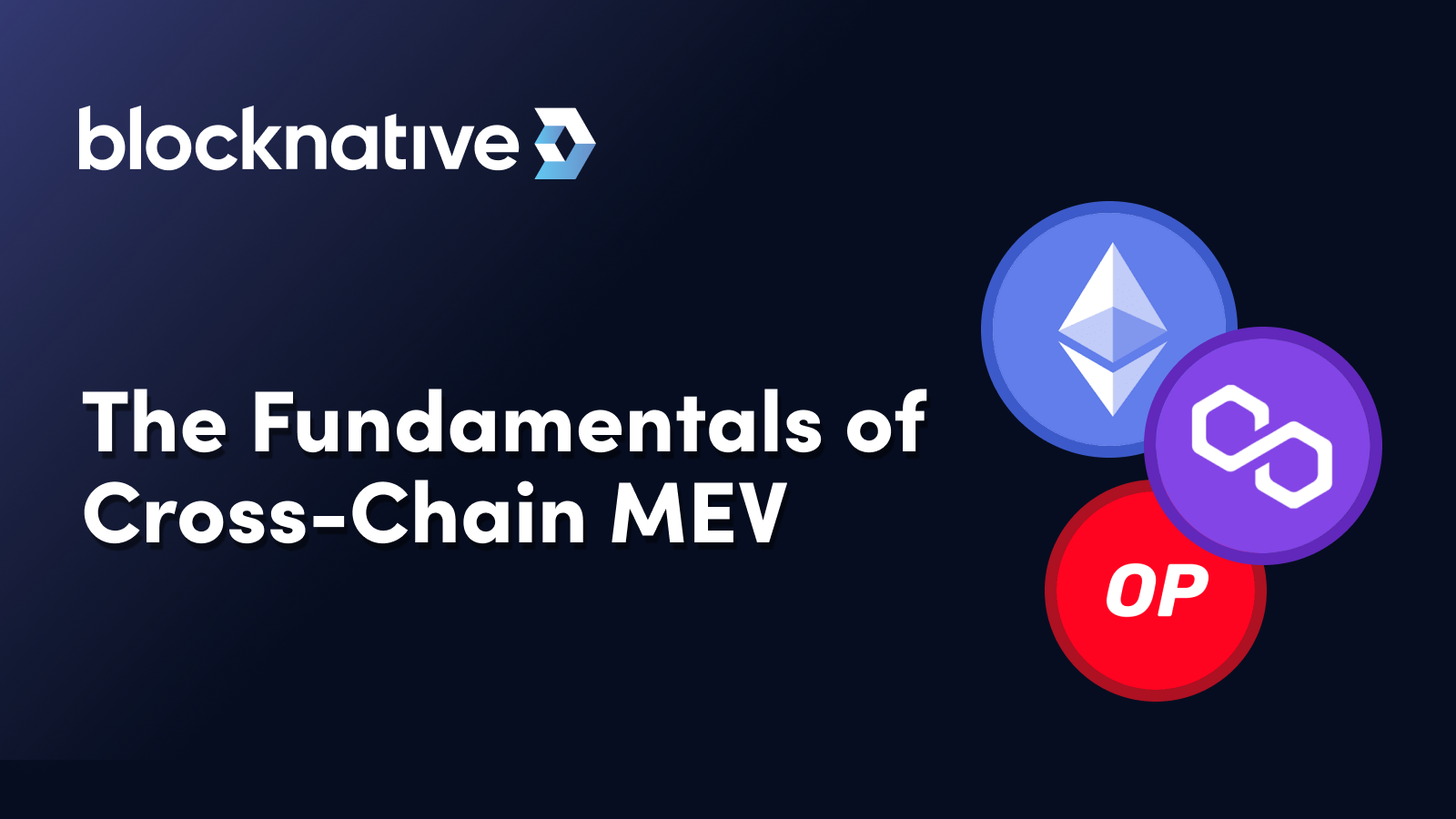Web3 is increasingly multi-chain and that comes with implications for everything from data transfer, to security, to, of course, MEV. As more DEXs increase their total value locked (TVL) on multiple chains, liquidity pools of the same asset pairs across multiple channels are formed but with different volumes and depths, creating new opportunities for trading and for MEV.
Check out Blocknative CEO and Co-Founder Matt Cutler's full presentation on the Fundamentals of Cross-Chain MEV below or read our recap here:
MEV and The Ethereum Merge
The Merge, a massive upgrade to the Ethereum network, forever changed the economics of infrastructure and the nature of MEV. With The Merge, the rate of issuance of new ETH for writing a block went way down; it's called the triple-halvening. As a result, while the MEV per block hasn't really changed all that much, the ratio of the value of the MEV and the block to the rate of issuance has gone way up.
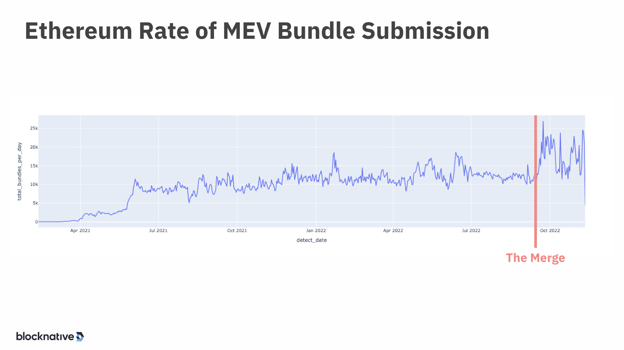
MEV now has a larger impact than it did under proof-of-work mining and the issuance regime that was in place at the time. Interestingly, it would also appear that there is more efficient extraction of MEV than originally predicted, as we have seen an increase in the rate of MEV bundle submission since The Merge.
MEV Illustrated
Traditional (Naive) Tx Ordering
Here’s a traditional or naive transaction ordering based on gas fees. On the left side here you have transactions in the mempool; the gas icons tell you how much gas is included in each transaction. On the right, you see a proposed block stack-ranked, with the highest gas prices at the top and lowest fees at the bottom. MEV occurs through transaction ordering manipulation.
%20%20TX%20Ordering%20Based%20on%20Gas%20Fees.png?width=624&height=350&name=Traditional%20(Naive)%20%20TX%20Ordering%20Based%20on%20Gas%20Fees.png)
Alternative Transaction Ordering
Of course, MEV is about creating a favorable margin through transaction ordering manipulation. So here's an example of an arbitrage opportunity in which a target transaction (in green) moves the price of a given asset on a given DEX. MEV is created when a response transaction (in red) takes advantage of the price differential on different DEXes. In order to realize the margin, the block must be ordered with the arbitrage transaction following the target transaction.
In the diagram, you’ll see the arbitrage transaction (red) immediately follows target transaction (green) thus successfully extracting the arbitrage opportunity by buying low index a and then selling high index B. This is generally viewed as “benign” MEV because the target transaction isn't harmed and the arbitrage helps establish price parity across various exchanges. For a deeper understanding of the negative externalities, read more here.
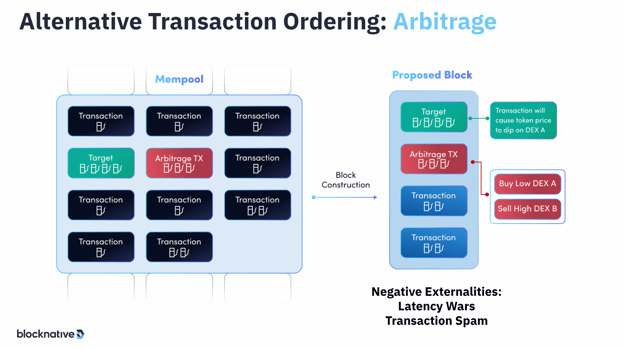
There are a variety of other types of MEV related to transaction ordering that are generally considered more toxic as it relates to the outcome for the user. These are known as front running, sandwiching, and suppression. We cover this in depth here. If you’re interested in tracking these types of activities, check out zeromev to watch these events unfold live and see how MEV impacts transactions.
Web3 is Increasingly Multi-Chain
Web3 is increasingly multi-chain and that comes with implications for everything from data transfer, to security, to, of course, MEV. Let’s look at the leading DEX, Uniswap, as an example. On Ethereum, Uniswap has a TVL (total value locked) of $3.8 billion. But Uniswap is now available in all sorts of other domains including Optimism, Polygon, and Arbitrum. That creates an additional $200 million, at least, of additional TVL associated with Uniswap on these other locations bringing the total TVL of UNICEF closer to $4 billion.
Because Uniswap is available in multiple places, the liquidity pools of the same asset pairs exist across multiple channels but with different volume and depth. This creates all sorts of new opportunities for trading and for MEV. In this example, we have Ethereum at the top, Polygon in the middle, and Optimism at the bottom but the order is arbitrary to this example. At the end of the day, it’s all about ordering.
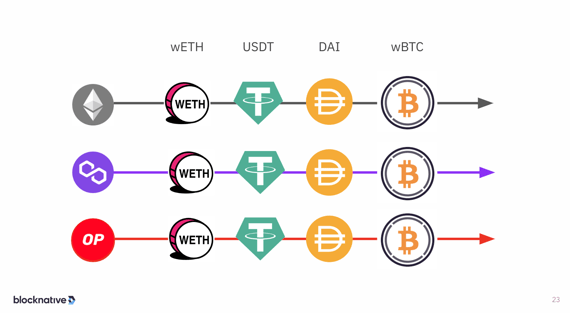
As discussed earlier, blockchains are ordered transaction systems. We need the ordering because without it, it’s impossible to determine how transactions will settle. To belabor the point: Where you have ordering, you create opportunities for MEV. What can happen within a chain can certainly happen for transactions between chains.
The Possibilities of Cross-Chain MEV
Westerngate gives us a couple of examples of cross-chain arbitrage. In the first, a two-way cross-chain arbitrage opportunity, a transaction starts on Polygon with USDT and through wrapped ETH, the USDT bridges over to Ethereum where it converts back to USDT on Uniswap but now with a higher value. This trader took advantage of USDT price variability on two different DEXes across two different chains for a gross profit of over $1,300.00.
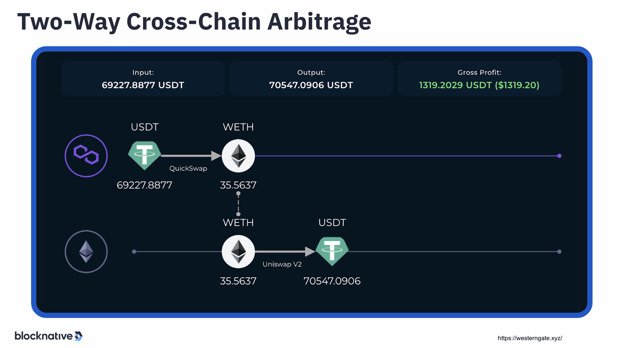
This type of arbitrage trading isn’t limited across two chains; a trader could operate across three or more chains to achieve similar outcomes. In a second example, a three-way, multi-chain arbitrage results in a gross profit of nearly $7,000 by moving DAI from Ethereum, through a bridge to Binance via USDC, converting to USDT on Binance and then to Polygon where the USDT converts to USDC again and back to DAI.
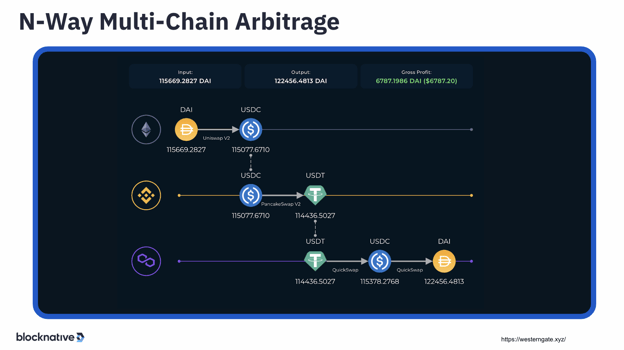
Can Cross-Chain MEV be Atomic?
As web3 becomes increasingly multi-chain, these cross-chain MEV opportunities will become more popular and more interesting. However, atomicity is essential to MEV. For MEV opportunities to occur the cycle must be atomic: something happened, or it didn’t. The multi-chain world is not very atomic, which creates all sorts of opportunities for risks that can be difficult to understand, measure, and mitigate.
While bridging, as described above, is the classic way to do cross-chain transactions, transactions take too long to settle and thus become unpredictable. During settlement time, others can capture MEV opportunities before the bridged transactions are completed. Parallel-chain MEV offers a solution.
To execute parallel-chain MEV, you have assets on one chain and assets on another and execute them simultaneously to capture the arbitrage. These transactions settle more quickly because they are not interlinked. But there are some negative externalities: Parallel-chain MEV requires resources on each chain and hence represents a centralization vector. Said another way, those traders or actors with more resources will necessarily outperform others because of the need to spread resources across chains.
Limitless Possibilities for Cross-Chain MEV
There’s multiplicity at play with cross-chain MEV, considering the number of chains, assets, and protocols at play, that raises some concerns. Theoretically, there's an unlimited number of unique paths to execute MEV, far beyond the possibilities within MEV on a single chain as well. Should these opportunities for exotic MEV be open and unbounded? This question and other will get answered in the months and years ahead.
Multiplicity and Transaction Ordering Across Chains
Now, imagine trying to control transaction ordering across multiple channels rather than just one. Let’s look at a specific example in which a single entity controls a significant stake in two different chains. This actor can do things in a probabilistic fashion that others cannot accomplish
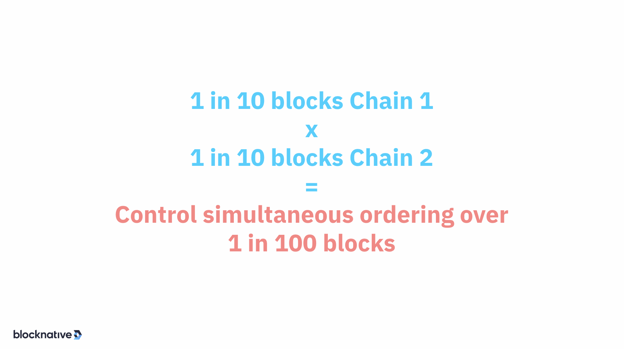
Imagine one entity controls 10% of the staking share on Chain 1, which amounts to controlling the ordering of one on every 10 blocks, and also has a 10% share on Chain 2. If they control one in 10 blocks on Chain 1 and Chain 2, this entity (assuming similar block times and other factors) can control simultaneous ordering in more than one out of 100 blocks or about 1% of the time. They're the tip of the chain. They can execute strategies and enable MEV to happen cross-chain because they can, a portion of the time, control two blocks simultaneously.
This can also make MEV a centralizing vector. While Ethereum is fairly decentralized, it’s quite expensive to operate staking, this is not the case for all chains. A small or not widely-held secondary chain may have actors with fairly substantial share there. These actors with 5% or even a third staking share can create pretty significant asymmetries by executing cross-chain and cross-domain MEV strategies because they control both chains simultaneously sometimes. Over time, the more resources these actors accumulate, the more resources they spread across chains, the more control they can exert over the whole ecosystem.
New Classes of MEV
There will be whole new classes of MEV that we can’t anticipate but researchers are actively exploring these: Cross-chain, multi-block and even more complex, even higher risk forms of MEV yet to be discovered. Generally, though, this game is for both the brave and the well resourced. Rest assured, though, it’s top-of-mind for the Ethereum Foundation.
Will Ethereum Tackle MEV?
Until a few weeks ago, the Ethereum roadmap consisted of The Merge, The Surge, The Verge, The Purge, and the Splurge. Now, sandwiched in the middle, is The Scourge, which purports to tackle issues related to MEV. Since The Merge, the MEV marketplace and block building expanded lending a new sense of urgency within the industry. The fact that The Scourge earned a spot ahead of tackling verkle trees and pruning gives some indication of the importance of reigning in MEV and the inevitability of a cross-chain future.
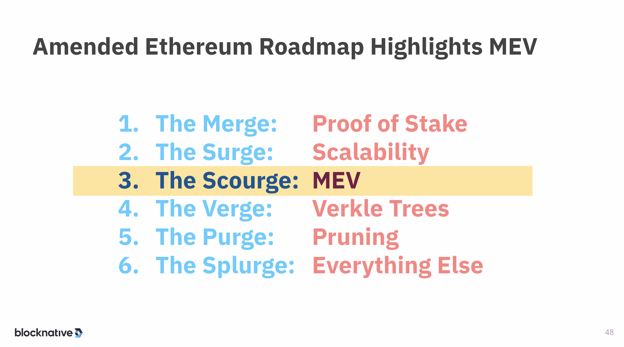
Cross-Chain MEV is a New Frontier
Now is the time for everybody to start preparing for a multi-chain future. While a lot of the cross-chain MEV feels exotic today, MEV itself also did only two years ago. In the next few years, multi-chain MEV will likely become pretty commonplace and certainly better understood.
You can prepare for and get involved in shaping this future by incorporating real-time mempool data into whatever you're building to facilitate transaction composition. This helps clarify gas estimation and transaction simulation so users understand what will happen to their transactions before committing them on-chain.
MEV Searchers can use Blocknative’s suite of tools to search with an edge and securely get MEV bundles on-chain by submitting to our RPC endpoint https://api.blocknative.com/v1/auction. Learn more by visiting our MEV bundle RPC endpoint docs. Our blocks generally make up ~10% of the network. Create a free Mempool Explorer account today and begin prototyping your strategies.
Validators can earn more by connecting MEV-Boost to the Blocknative Relay endpoint. Connect to our relay today to maximize your block rewards.
Gas Extension
Blocknative's proven & powerful Gas API is available in a browser extension to help you quickly and accurately price transactions on 20+ chains.
Download the Extension
